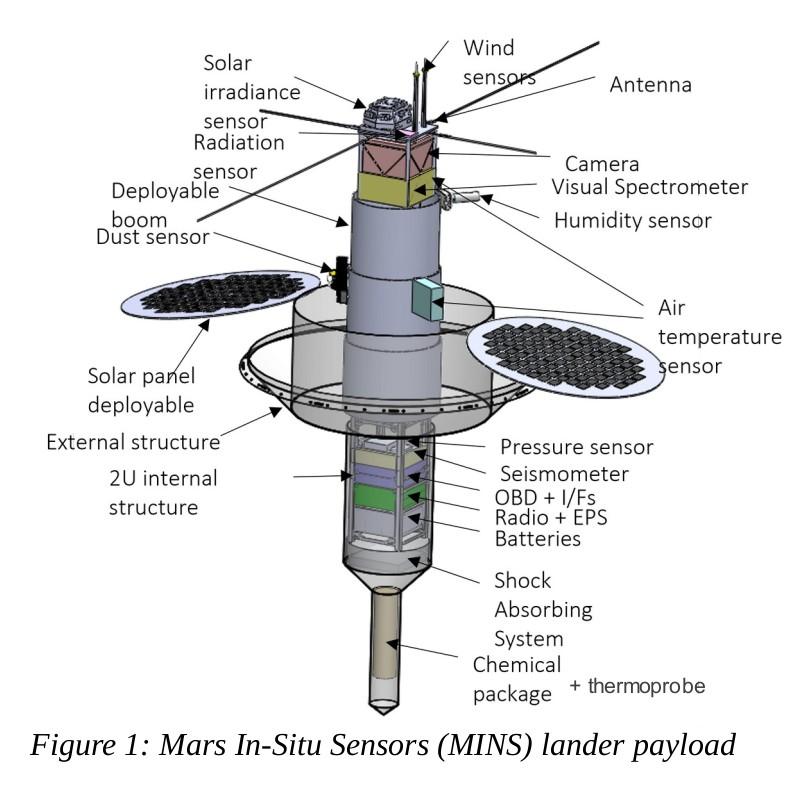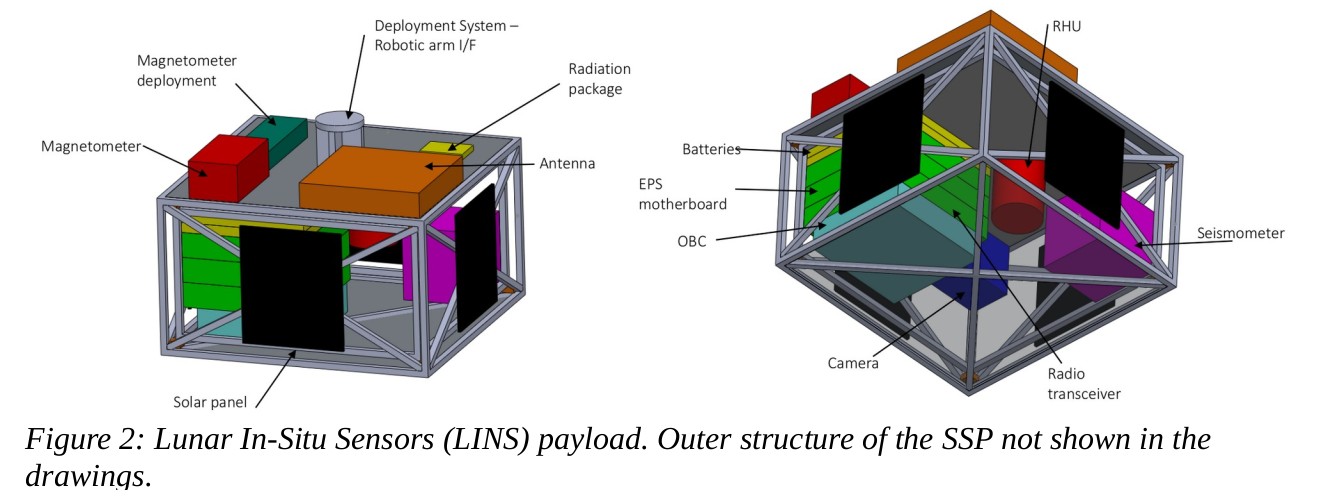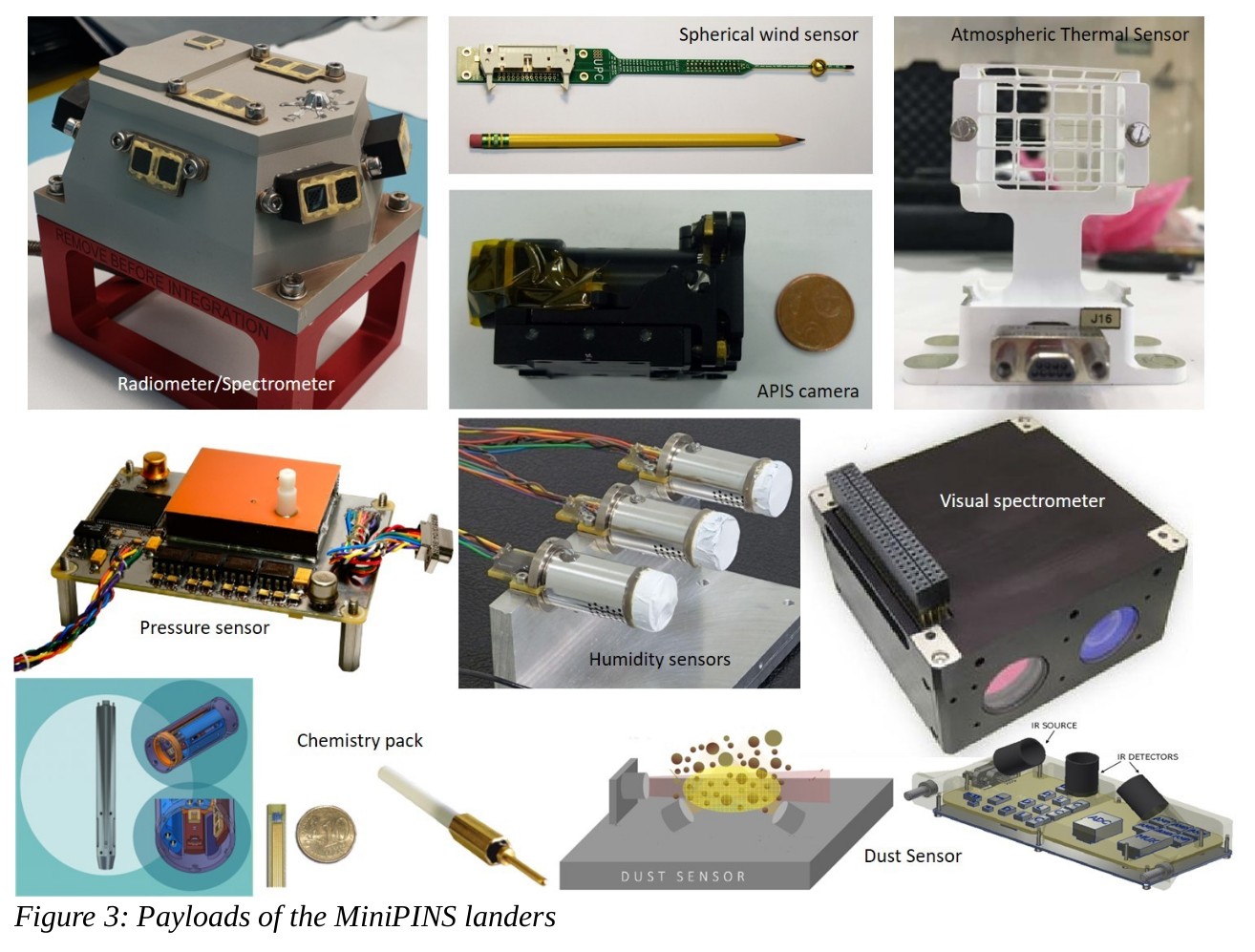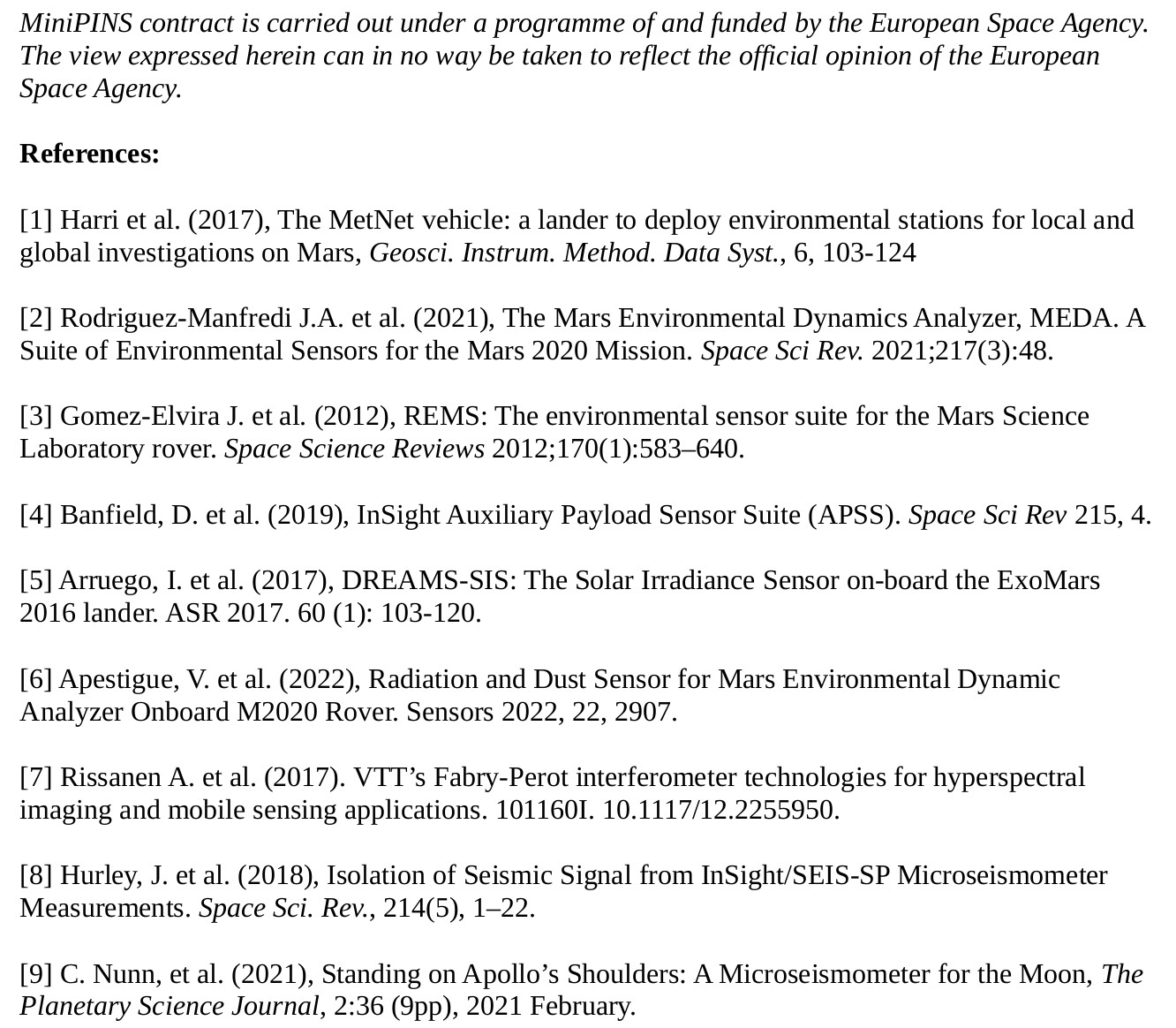- 1Finnish Meteorological Institute, Space research and observation technologies, Helsinki, Finland (maria.hieta@fmi.fi)
- 2Instituto Nacional de Técnica Aeroespacial (INTA), Madrid, Spain
- 3Added value Solutions (AVS), Elgoibar, Spain
- 4Universitat Politècnica de Catalunya (UPC), Barcelona, Spain
- 5Instituto de Microelectrónica de Sevilla (IMSE), Sevilla, Spain
- 6Institute of Advanced Studies of Madrid in Nanoscience (IMDEA), Madrid, Spain
- 7Centro de Astrobiología (CAB, CSIC-INTA), Madrid, Spain
Introduction:
MiniPINS is an ESA study to develop and prototype miniaturised surface sensor packages (SSPs) for Mars and the Moon. The study aims at miniaturising the scientific sensors and subsystems, as well as identifying and utilizing commonalities between Mars and Moon SSPs, allowing to optimise the design, cut costs and reduce the development time.
Mars In-Situ Sensors (MINS) is a penetrator with approx. 25 kg mass, piggy-backed by another Mars mission spacecraft to Mars. In total 4 identical penetrators are deployed to different landing sites either from the approach orbit or Mars orbit. The design of MINS has significant heritage from FMI’s MetNet mission design[1]. The entry, descent and landing sequence of MINS is completely autonomous and controlled by its on-board computer. In the Martian atmosphere the penetrators undergo aerodynamic braking with inflatable breaking units until they reach the target velocity of 60-80 m/s for entering the Martian surface. The nominal mission duration is one Martian year.
Lunar In-Situ Sensors (LINS) is a miniature 7 kg station deployed on the Moon surface by a rover. LINS mission consist of 4 surface stations deployed to different sites within the rover’s traveling perimeter. The LINS scientific package consists of several scientific instruments to study the Moon for 2 years.

Mars SSP sensors:
MINS will study the Martian atmosphere, seismology and chemistry. The MINS payload consists of a camera, a visual spectrometer, a meteorological package, an impact accelerometer, soil thermoprobes, a chemistry probe, a seismometer and a radiation monitor. Many of the instruments have Mars heritage but additional qualification is required due to landing shock.
The meteorological package consists of air temperature sensors, pressure sensor, relative humidity sensor, wins sensors, dust sensor and solar irradiance sensor. Pressure and humidity sensors are provided by FMI and the sensors have heritage from multiple Mars missions like the M2020 Perseverance rover[2]. Air temperature sensors are provided by CAB and they have heritage from MSL[3], InSight[4] and M2020[2]. Solar irradiance sensor (SIS)[5] is provided by INTA and the technology has been used in several Mars missions[6]. The selected design for MiniPINS is the SIS for ExoMars ‘22. Also based on ExoMars ‘22 METEO is the dust sensor by UC3M.
The chemistry probe is a new design developed by CAB. It is composed of several miniature sensing needles that share an acquisition electronics to measure pH, salinity, water content, conductivity and temperature of the Martian regolith. The current TRL is 6. The thermoprobe is also a new design developed by UPC for characterizing the thermophysical properties of the regolith.
The visual spectrometer selected for MiniPINS is based on tunable Fabry-Pérot interferometer (FPI) technology by VTT Technical Research Centre of Finland[7]. The piezo-actuated FPI technology has previously flown on board nanosatellites Aalto-1, Reaktor Hello World and PICASSO demonstrating operation in different wave lengths. Due to its maturity and flight-proven performance, the near-IR concept is the baseline for the MINS spectrometer.

Moon SSP sensors:
LINS proposal is focused on two principal science objectives: understanding the structure and composition of the lunar interior and the characterization of the lunar surface environment in view of human exploration and resource extraction. The placement of a network of short period seismic stations will allow determining the thickness of the lunar crust (upper and lower) and its lateral variability. Due to smaller size the LINS has fever scientific sensors and many are common with the MINS packages. Magnetometer selected for LINS is based on the triaxial magnetometer developed by INTA for MetNet Mars mission. The sensor will require some modifications and adaptation of the ejection mechanism as well as temperature qualification for Lunar conditions.
Shared sensors:
The cameras of both MINS and LINS are based on the Athermalized Panchromatic Imaging System (APIS) low-resolution refractive camera used by INTA as a CubeSat payload which flew on-board the OPTOS satellite. It is based on a 1.3 MP CMOS image sensor from Cypress Semiconductor Corporation but the optics will be redesigned taking into account the applicable requirements for each mission.
Miniature wind sensors (Mars) and thermoprobes are based on the same sensor structure developed by UPC. The new type of sensor is a spherical shell divided into four sectors. To sense temperature and provide heating power, a customized 3 x 3 mm silicon die, including a platinum resistor, is attached to the inner side of each sector. In MINS the wind sensors are located in the deployable mast and the soil sensor is in a compartment below the surface in contact with the regolith. For LINS a dedicated deployment mechanism must be developed for the soil probe. The wind sensors and soil probes are currently in TRL 6.
The short period seismometer is based on a miniature MEMS resonator by Imperial College, previously used in InSight[8]. For LINS a variant of the sensor, called the Silicon Seismic Package, (SSP)[9] is proposed.
The impact accelerometer of MINS will be a new development. To miniaturise the accelerometer, a commercial part from PCB Piezotronics has been selected as the basis of the sensor and the complete sensor assembly will be developed and qualified by INTA. Lunar SSP also includes an accelerometer which is used to determine the attitude of LINS. It is based on an Analog Devices component ADXL327BCPZ, already qualified by INTA for Mars, but LINS missions requires even larger temperature range so additional qualification is foreseen.
The radiation monitors included in both missions are based in the Metal-Oxide-Semiconductor Field-Effect-Transistor (MOSFET) dosimeters. Proposed provider of MOSFET dosimeters is Tyndall National Institute.

Project status:
The MiniPINS study, consisting of project phases A and B1, is nearly completed and a final review was held in autumn 2021. As a follow-up, the European Space Agency is facilitating an industrial development of European inflatable deceleration system.

How to cite: Hieta, M., Genzer, M., Haukka, H., Kestilä, A., Arruego Rodríguez, I., Apéstigue Palacio, V., Reina Aranda, M., Gonzalo Melchor, A., Martínez Oter, J., González-Guerrero Bartolomé, M., Ortega, C., Camañes, C., Dominguez-Pumar, M., Espejo Meana, S., Guerrero, H., and Rodríguez-Manfredi, J. A.: State-of-the-art miniaturised science instruments of the MiniPINS landers, Europlanet Science Congress 2022, Granada, Spain, 18–23 Sep 2022, EPSC2022-820, https://doi.org/10.5194/epsc2022-820, 2022.

